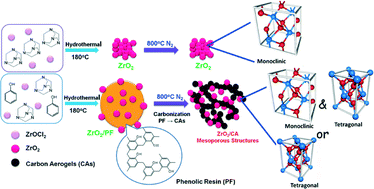Synthesis of a ZrO2/carbon aerogel composite with tetragonal ZrO2 structures assisted by the formation of phenol formaldehyde resin
Abstract
In this study, monoclinic ZrO2 nanoparticles were successfully prepared using a hydrothermal process. When phenol was added to the resulting solution for the hydrothermal reaction, ZrO2/phenol formaldehyde (PF) resins with tetragonal ZrO2 crystalline phases were synthesized. Tetragonal ZrO2 crystalline phases favor growth in solutions with high pH values and high OH− concentrations, which result from the formation of PF via the reaction of phenol and formaldehyde. Consequently, the transition of monoclinic ZrO2 to tetragonal ZrO2 is assisted by PF formation. Furthermore, tetragonal ZrO2/CA structures with a high specific surface area of approximately 275.7 m2 g−1 were successfully prepared through carbonization of the resulting ZrO2/PF structures, which greatly improved the aggregation phenomenon of ZrO2 nanoparticles with a specific surface area of ca. 16.1 m2 g−1. This study is the first report of the fabrication of tetragonal ZrO2 crystallites with the assistance of the formation of phenol formaldehyde resins during hydrothermal reactions. This method could be applied to other metal oxide crystallite systems in the future.


 Please wait while we load your content...
Please wait while we load your content...